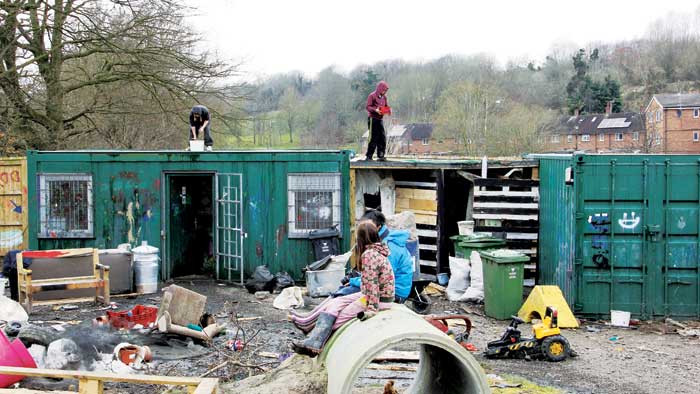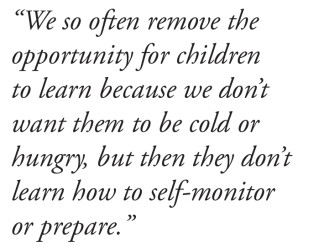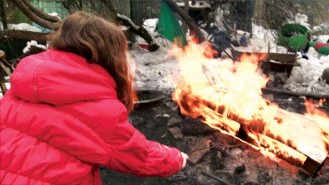
Kids play at The Land, a playground in North Wales, U.K. where they get all the tools they want to create whatever they want. By American standards, the play space is rampant with hazards, but some child experts advocate that children need to encounter risks to overcome fears and build confidence. The green shipping container at back is known as The Office where kids first stop after entering The Land to pick up items of their choice. (Photos courtesy of Erin Davis)
A fence covered in graffiti borders a muddy plot of land. Inside, a pile of tires and large wooden crates clutter the area.
Like an Eye Spy puzzle, more and more unusual items are spotted—a couch without cushions, pieces of tubing from playground slides, torn-up cardboard, muddied Barbie dolls, dress-up clothes, hammers and saws a little rusty from rain.
Everything is discolored from a faint cloud of dirt and sweat. What is this place? “Chaotic junkyard” might be one way to describe the scene.
 This is an adventure playground in North Wales called “The Land.” Adventure playgrounds give kids whatever tools they want to create whatever they want. Kids light fires, saw cardboard, build forts and more.
This is an adventure playground in North Wales called “The Land.” Adventure playgrounds give kids whatever tools they want to create whatever they want. Kids light fires, saw cardboard, build forts and more.
“Children love gypsies, cowboys, clowns, circus people. They love free spirits and children are free spirits. They are innately adventurous,” says Erin Davis, Vermont-based filmmaker whose documentary on The Land comes out this fall.
Davis says kids will play anywhere with anything—The Land indulges that interest with infinite challenges for kids to master. Kids, rather than adults, direct the play any way they wish, unless there is a hazard. By mastering challenges children overcome fear and learn to manage risk—skills kids with “play deprivation” can lack, according to some child experts.
Adventure playgrounds began in Denmark during World War II. A Danish landscape architect noticed children preferred to play everywhere except the playgrounds he built. They played with rubble and junk so he built a “junk playground” with tools and moveable structures. “Junk playgrounds” became known as adventure playgrounds.
Currently, about 1,000 exist in Europe, but adventure playgrounds have not taken off in the U.S., with one in Berkeley, Calif. and another in Ithaca, New York. However Davis says she gets daily emails from strangers who are interested in them. “I think people are ready for this but don’t really know how to make it happen, or don’t realize how easy it is to start supporting play.”

As first look, The Land appears a chaotic junkyard, but thought and design goes into each element. Children will play anywhere with anything—The Land indulges that interest, according to filmmaker Erin Davis, whose documentary on The Land comes out this fall. For more information about the movie visit TheLandDocumentary.com.
By American standards, the playground seems crazy—a toxic trap ready to break, burn and bleed. But Davis says The Land is actually very safe. Children take risks at their own pace, beginning small and working up to challenges like sawing wood.
If there is hazard, “play workers” or trained adults step in, but do so thoughtfully. Rather than telling a child what to do, they collaborate on a problem. “Is it hard to saw cardboard while sitting on the arm of a couch?” a play worker might ask.
At times the kids swear or do strange things adults may be inclined to correct, but at The Land the child’s adventure is more important than an adult feeling uncomfortable.
“A child has the human right to play,” Davis says. “If you watch a child and see what they do at their own initiative, and compare that to what we give them, it’s a huge discrepancy.”
She compares traditional fixed playgrounds to giving a child a red crayon and a piece of paper. But give a whole box of crayons and a piece of paper, and suddenly a child can create much more.

A girl pokes a fire. Unlike traditional playgrounds, adventure playgrounds are designed for children to take incremental risks. They start small and gradually take bigger risks when they’re ready.There’s no potential for them to jump beyond their ability and be seriously injured, according to Erin Davis.
Davis, 33, was brought up the way many say no longer exists. She grew up in a middle class home in Cincinnati, Ohio. After school she and friends came back to her house, dropped off their backpacks, raided the fridge, and went outside until the streetlights came on. The next day they did the same thing.
While she had a playful childhood, she knows it was more restricted than her parents’ childhood, which was more restricted than their parents’. Davis is concerned about the narrowing of childhood experiences.
She argues if we care about play, we need to step up our game and make play more appealing, especially when it’s competing with video games and iPhones. This also begins in the school system.

A young boy saws a piece of cardboard.
Kaitlin Schmidt, a kindergarten teacher at Paddington Station believes Paddington is one of only a few schools in Northeast Denver that operates by the philosophy, “Learn through play.”
“We have to defend ourselves often because people say it’s not learning,” Schmidt says. “But children need different avenues to learn.”
Once a day her class has choice time and twice a day time outside—sand, a stone castle, big field and hill. During play, there are restrictions but kids explore on their own. They learn to compromise and make their own decisions. If a child chooses not to wear a jacket in winter and gets cold, the class shouts “Too bad so sad!”
“We so often remove the opportunity for children to learn because we don’t want them to be cold or hungry, but then they don’t learn how to self-monitor or prepare,” Schmidt says.
Dr. Mindy Solomon, child psychologist at Children’s Hospital Colorado, encourages working on independence when kids are young and make little mistakes rather than potentially fatal mistakes when they’re older.
Oftentimes, loving, well-intentioned parents struggle with letting kids’ situations play out naturally, she says. Observe a playground situation and notice how often parents talk, whether it’s encouraging something good or discouraging something risky.
While The Land only reports skinned knees and bruises, parental fear is inevitable. Looking at photos of The Land, the first words that came to parents’ minds were “heart attack,” “danger” and “injury.”
Letting kids take risks is also a risk for parents, but Solomon says it’s important to let kids fail. “Knowing no matter what life throws at you, you have the skills and abilities to pick yourself back up is the most empowering confidence builder you can have as a child or adult.”
At times, even Davis has had to remind herself The Land is safe. She says people understand and like the concept, but there has been little support to bring these playgrounds to the U.S.
Before visiting The Land, she once took a group of kids to a lake. Each child wore a life jacket and knew how to swim; yet the 15 feet of water beneath their paddleboat stirred terrifying images of a child drowning.
After months at The Land and never seeing a serious injury, she now looks back at being on the paddleboat and wonders why she was so scared. “Our fears are incremental down to the very smallest moments, like drawing outside the lines. But really, what is at stake here?”
As they say at The Land, it’s better to have a broken bone than a broken spirit.
Watch a teaser of The Land.



Stapleton is the perfect location for a playground like this. Sign me up.